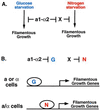Interplay of intrinsic and extrinsic signals in yeast differentiation
- PMID: 11095703
- PMCID: PMC34079
- DOI: 10.1073/pnas.011511198
Interplay of intrinsic and extrinsic signals in yeast differentiation
Figures


Comment on
-
Glucose depletion causes haploid invasive growth in yeast.Proc Natl Acad Sci U S A. 2000 Dec 5;97(25):13619-24. doi: 10.1073/pnas.240345197. Proc Natl Acad Sci U S A. 2000. PMID: 11095711 Free PMC article.
References
Publication types
MeSH terms
LinkOut - more resources
Full Text Sources
Molecular Biology Databases

